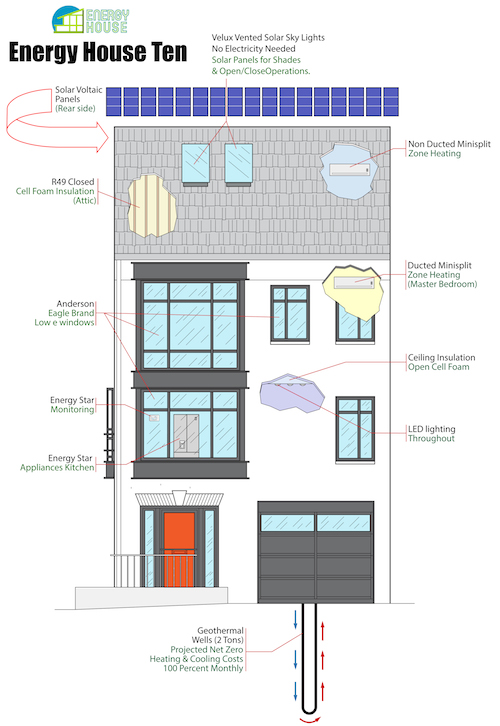
Original line drawing courtesy of Karen M. Conkey architect LLC
Keeping the Charm, While Losing the Bills: How One Couple is Remodeling Their Old Town Row House Using Energy Efficient Systems
Walking along North Union Street near Founders Park, the row houses pull you into the history of Old Town Alexandria. As you walk through the city, you imagine how novel it must be for the owners of these homes to be able to live among the storied history of the city. Though the thought of living in a home in Old Town is certainly appealing, the reality is quite different for some residents. Drafty windows, cold floors, and rooms of varying temperatures can make homeowners feel like they are living in the days of petticoats and tricornes.
One such home is undergoing a massive remodel and energy upgrade that is being led by Federal Contracting, the architecture firm, Karen M. Conkey architect LLC, and Energy House. The house was built in 1971 and the owners have been living in the house for more than 10 years. They knew that it was time for the house to be updated, and while they were at it, they thought it was the perfect time to make the house more energy efficient. The house is located on Quay Street, which affords the owners an enviable location with expansive river views. The inside is drenched in sunlight and the pièce de résistance is the office on the top floor that boasts a Palladian window overlooking the river, four large skylights, and a fireplace. After living in the house for a while, the couple realized that the location of the house posed heating and cooling challenges, but fortunately, it also provided a way to harness the power of the area’s natural resources.
Energy upgrades began on August with geothermal drilling in the front of the house. As the major component in the planned hybrid HVAC system, geothermal takes advantage of relatively constant subterranean temperatures to provide heating and cooling. And, unlike a traditional HVAC system, geothermal systems will last from 20-30 years. The other part of the hybrid system includes the installation of mini split units allowing for five temperature zones throughout the house. The homeowners will receive a 30 percent federal geothermal tax credit, which helps reduce the payback on the hybrid system to only 5.3 years.
Energy House is also adding open and closed-cell insulation in the roof, attic, walls, rim joists, and shed dormer. Two of the existing skylights will be replaced with solar powered venting units that run exclusively off of their own solar panel. All windows and exterior doors will be replaced with ENERGY STAR products. For an added energy-saving boost, solar panels are planned for the house pending the approval from the city. The couple is also considering adding smart technologies to the home including energy monitoring, home sensors, security, and audio/video. With all of the planned energy upgrades, the estimated monthly utility bills for the home’s heating and cooling are projected to be $55.00, down from an average of $300.00 to $500.00 per month using electric heat pumps. If the solar is approved and installed this project may come very close to net zero on its heating and cooling costs.
The outside of the home will maintain its original character, while the inside will include a contemporary update with a nod to the past. Best of all, the house will be both beautiful and energy efficient. Tours of the home, also known as Energy House 10 as part of the company’s long line of showcase homes, will be held in March.
To receive updates on Energy House 10, subscribe to our newsletter.



